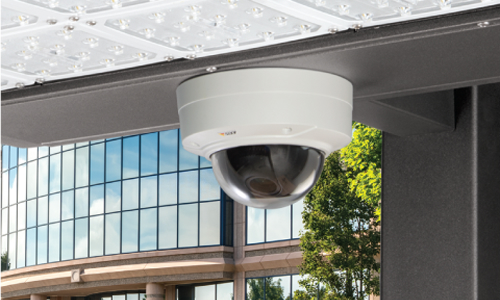When it comes to keeping people and property protected, LED lighting is an essential piece of the puzzle. The nature of outdoor security is complex and often requires integrating multiple components with several trips to the top of a pole, making for overall expensive installations.
Many healthcare, higher education and school security professionals have yet to consider the power of exterior LED lighting and why it’s an ideal platform for security solutions. Not only does lighting give people a sense a comfort and safety, but with current solutions available on the market there is also an opportunity to enhance security from within the luminaire. Additionally, these types of installations can help a hospital, school or university cut costs.
To understand how LED lighting can improve safety and security, Security Sales & Integration, CS’ sister publication, took up the topic with Jay Sachetti, senior marketing manager for lighting solutions provider Eaton, and technology consultant Dave Klepp, founder of Engineered Systems Services.
What is the relationship between LED lighting and security solutions?
Klepp: Security cameras need quality light to be able to capture quality images. Newer cameras are better at seeing in lower lighting, but they often use infrared LEDs to achieve this. Luminaires provide far superior lighting to capture the best image. Compared to cameras that use infrared light — which makes images look black and white in the dark — luminaires provide the ability to see clear color images at a much further distance.
The infrared LEDs in a camera have a limited range compared to available solutions on the market, which can have a greater range to illuminate a huge area. This produces more well-lit, quality color footage and the peace of mind of clear security lighting.
Sachetti: Light poles are also evenly spaced in exterior areas — throughout the parking lot, around the perimeter of the property, at the frontage or near trails and other areas you want to surveil, so they offer the perfect vantage point for a camera.
How can connected lighting solutions help streamline an installation’s workflow?
Klepp: Due to the myriad benefits, many businesses and facilities are upgrading to LED lighting. One of the best things about LED lighting upgrade projects is that the power savings pay for the lighting and often even the security solution over time. And, if campuses upgrade their lighting, bucket trucks will already be out to replace the fixtures, and can easily add security cameras at the same time.
In typical security installations, integrators have to buy all the components, integrate them all into an ugly outdoor box, get the box up on the pole — often even install the pole itself — order power to be connected and then come back again to install the camera. In many cases, they have to use two separate poles, because the one the power comes from is owned by the power company, which won’t allow anything else to be installed on it. All of this can result in two to four separate trips with expensive bucket trucks.
Sachetti: Eaton’s LumenSafe integrated network security camera offers a camera directly integrated with the lighting fixture. This allows free installation of your security solution and is ideal because installation is otherwise a huge cost and inconvenience for security integrators.
With a lighting platform that has an integrated camera, there can be one trip up in a bucket truck to install the LED fixture while reaping the benefits of not only free installation of the security solution but also the free pole and power too.
How does connected lighting help solve campus customer concerns about security solutions?
Klepp: Necessary security views are often not available without putting cameras up on poles. Oftentimes, when customers reach out to security integrators, their proposals are declined because it is so expensive to separately install the pole, box, power and cameras out there. To be honest, the end solution is also pretty ugly.
Saving money and energy is always a priority for customers. Unfortunately, this priority can lead to customers trying to install security devices on their own, but then the complexity of these projects often leaves them frustrated and discouraged.
With a solution that integrates the camera and the LED fixture, though, the energy savings over time are significant enough that they can essentially pay for the lighting upgrade and the entire security solution, and the comparative ease of installation allows customers to get a better solution much easier and faster.
For those customers who are concerned with security cameras that offer subpar building-mounted vantage points and lighting that is poor or blinding their cameras, lighting systems with integrated cameras offer the best of all worlds. Since the camera is part of the luminaire, the feed is always well-lit.
Sachetti: Completely integrated solutions solve the challenges of security integrators by leveraging the real estate of LED luminaires for faster installations and increased energy savings. Customers can have peace of mind in trusting the security solution’s effectiveness.







